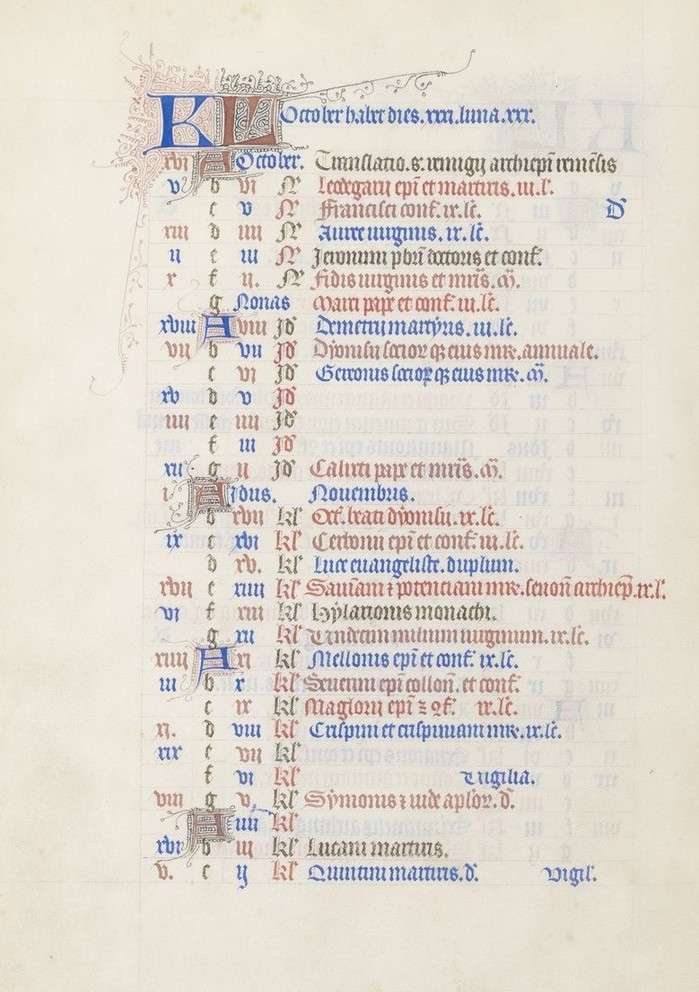A slew of Spanish Hours are coming in the near future, thanks to the detailed catalogue information in Josefina Planas’. Horae: el poder de la imagen : libros de hores en bibliotecas españolas. (Madrid: Orbis Mediaevalis, 2016). These are mostly not actually Spanish-made manuscripts, sadly, but a broad spectrum of French, Flemish, and Italian MS that are presently held in Spanish collections.
The first of these to be added is from the Biblioteca Nacional de Espagna, Vitr 23 10. This 13th C Parisian book is known as the Clinton Book of Hours, from the 15th C british owners. This manuscript starts with a long pictoral sequence, depicting two scenes of St. Edward the Confessor and then the life/death/resurrection of Jesus, leading to the calendar starting on f.29v.
The calendar itself is not graded, it uses gold and blue ink without obvious pattern. There is a tendency for lone important feasts to be gold, but when entries cluster they fall to simple alternation. Outside the main entries there are some of the Zodiac signs, 5 months, and many of the other informational notes (dates for easter and Rogation Keys). There are also several obituaries for members of the Clinton family in a later hand, in brown ink. The main entries are rather sparse, 142 dates populated, and most are the basic Parisian saints. With the exception of a row shift at the beginning of October(see f.37v below), the entries are accurate with only one incorrect entry elsewhere.
(DB Id: 279)
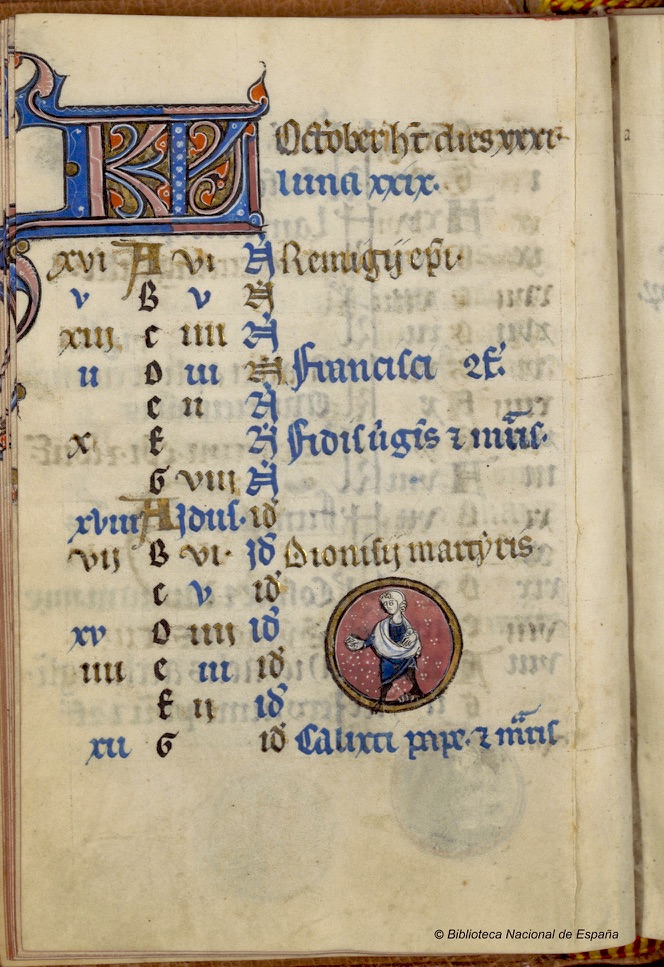
The second manuscript from the backlog is from a new archive, the Beinecke Library at Yale, one of the largest collections of medieval manuscripts in the US. MS 663 is an early 16th Century Book from Tournai, now in Belgium. The calendar is almost entirely undecorated, only gold and colored KLs to start the month, but the overall manuscript has a large number of complex miniatures.
An interesting bit of scribal practice is revealed errors in the calendar. January begins on f.4v, so that each month is a complete opening, however the second half of January, properly f.5r, is on f.4r. This points to scribal error, possibly the scribe noticed that he had mis-copied Anthony (1272) as a Monk on January 17th, where he should be properly a Confessor, Abbot or Hermit. Since the recto was not needed before the start of January, he was able to save the parchment without the need to scrape it. Why the second half of the month would have been done before the start is unclear, but since the red ink is missing from f.4r, this seems more likely than that he put the first part of January on the back of the wrong leaf.
The calendar entries are extremely accurate, with only three noted errors, all of which are at the start of the month. Due to an error in the layout of the page, the short verses for June take up the space of the first of the month(see f.9v below). The entries for June 1 (Nicomedes) and 2 (Peter and Marcellini) were shifted to June 2 and 3, to compensate. More interesting is Brigid, usually February 1, appearing on January 31. Shifts across month divisions are extremely rare.
Finally there is a bit of a mystery in the calendar, October 9 has Bishop Dyonisus, the most common name for the date, in black ink, followed by a word I read as “mesda”, in red. I’ve been unable to find a useful meaning for this word.
(DB Id: 270)
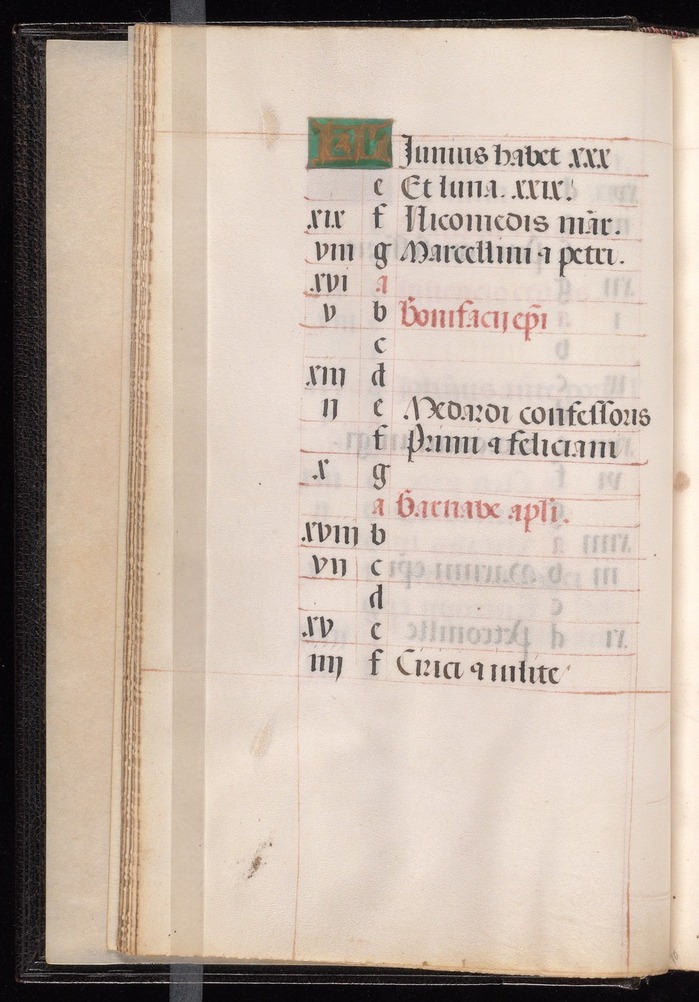
The Utopia, armarium codicum bibliophilorum collection (roughly translates to bookshelf of book-lovers) hosted at e-Codices is the location for privately-held manuscripts who’s owners allowed them to be digitized, but do not wish to be known. From that two books have been recently added, cod.109 and cod.111. Both of these are mid-15th century manuscripts from France, but after that they are distinctly different.
Cod.109 is from Angers, once the capitol of Anjou and about 300km from Paris, and dates from about 1430. It isn’t an unusually beautiful hours, but nicely executed with bright colors and wide borders filled with tiny leaves. The calendar is mostly full, with about 50 empty dates, though there is not a single feast with 2 different saints, not even the common pairing of St. James 1761 and St. Christopher 1757 on July, 25. The error rate is pretty low, only 18, but they seem to come in groups. Some unusual saints seem to reflect the uncommon use, such as St Gratian 3418 (in red) on October 23.
(Db ID: 260)
A quick summary of several Books of Hours added from my most recent trip to the Morgan Library in New York.
- M.141 - A late 14th C Parisian book, with a simple red/black complete calendar. There are errors in the listings, but no more than the usual number. The later months have multiple unidentified saints, including a saint “Olati” for Dec. 10 and Saint “Dani” on Dec. 5. (DB Id: 234)
- M.729 - The Hours of Yolande de Soissons, this is a Psalter/Hours, but has been added due to the unusually specific location, Amiens, and the rather precise date, 1280-1299, for such an early book. The Calendar has some specific-to-Amiens feasts, such as the Octave of St. Firminus, October 2. It’s triple graded as well, with blue for high importance and red for more medium-weight saints, though that is not a definite interpretation. (DB Id: 77)
- M.739 - This is a particularly old hours, 1204-1219, and from Moravia, which is a rare location. The calendar is damaged for the month of January, with the last 10 entries very difficult to read. There is also evidence of multiple generations of writing and rewriting, including additional saints and obituaries. Five entries for November were erased and rewritten, and it is unknown if these were changed. Of the saints from the original strata there are many unusual ones, such as St. Columba, along with the usual Pope Silvester, on December 31. Multiple saints are not yet identified. (DB Id: 175)
- M.1054 - A nice late 15th C book of hours from Tours, decorated, according to the catalogue by a “Distant follower of Jean Bourdichon”. The calender has a fantastic architectural border on the rectos, with the zodiac and the labors integrated into the frame. Interestingly the calendar is unevenly split, with about 20-22 entries on the recto and only a few on the versos. It is almost complete, but several months have a missing name for the last of the month. (DB Id: 228)
- S.9 - A Parisian book, illustrated by two associates of the Luçon master. The calendar is error-filled, both containing many saints on the wrong date as well as having many of the initials incorrectly filled in as ‘S’, such as “Sostre Dame” for Nostre Dame and “Ses Innocens” for Les Innocens. (DB Id: 226)
Note that with these additions, the total number of entries in the DB is 48910, 31951 of those have at least one saint.
Houghton Library MS Typ 51 is a tiny (see below with iPhone) Book of Hours from France, dated to 1552. Though the title page and some running titles are in French, all of the prayers and the Calendar are in Latin. The calendar is mostly complete, 340 feasts and a few zodiac entries, but has enough blanks that it isn't clear it was ever intended to be full. The saints are a mish-mash, many are weeks or even months off of the proper date. Interestingly, unlike many of the complete Parisian calendars, some, but not nearly all, of the saints have titles (Bishop, virgin, etc). Some of the unusual errors are: Abdon et sennem (Abdon and Sennen) on March 30, their feast is July 30; Scolastice (St. Scholastica) on April 10 instead of February 10; Cleti pape (Pope Cletus) on November 5th, October 12 is his closest feast. Besides these large errors there are numerous saints shifted by 2-4 days, some be as much as a week or 10 days within the same month. There are also many unidentified saints who might be shifted from elsewhere in the calendar. In total I count 29 errors, or almost 10% of the total entries, not counting unidentified saints who might be erroneous.
(DB Id: 224)
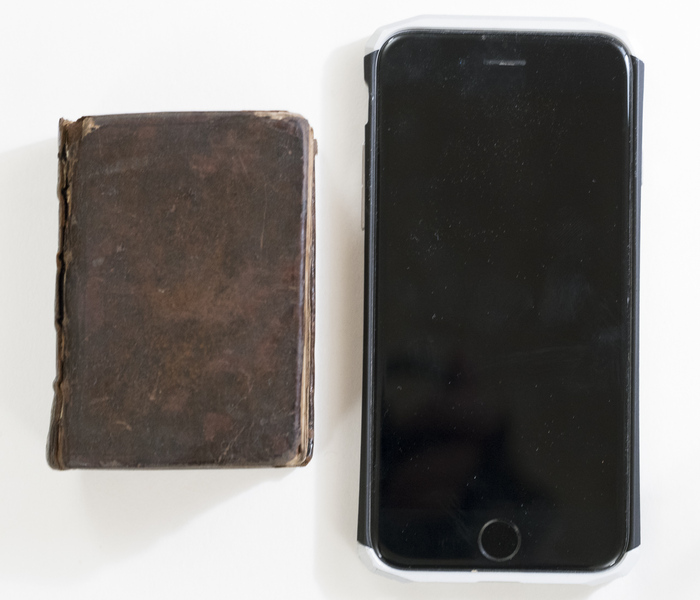
Trinity College, Cambridge, B.13.11 is a strange Hours from the late 15th century, created in Tournai, in Belgium. It is both liturgical and calendrical use of the city. The decoration is of a common style, with semi-illusionistic flowers over yellow borders around miniatures, but not of a very high quality.
The calendar, however, is highly detailed and unusual. It is approximately 2/3 full (241 dates populated), but with a total of 276 feasts, counting the 35 days with double names. Days are marked with the liturgical information (proper vs. common, # of lessons, duplex, triplex, etc) and double-feast days often have seperate information for each. A large number of pearled, equal-armed crosses have been, rather crudely, drawn in the margins. In the entries there are a number of very specific-to-Tournai feasts: both the feast (4152) and the octave (4153) of the dedication of Tournai Cathedral, along with St Martha (4157) on October 16 and both the feast of St. Piat (Piatus of Tournai, ᛭286 3195) in red and his octave (4156). One interesting scribal note is that the golden numerals, on the left side, are in often darker shade of red than the “red” saints.
(DB Id: 222)
Back to the Morgan Library for M.493, the Morgan Black Hours, so called because they are written in silver and gold in on black-stained parchment. The bad news is that this treatment makes the illumination, particularly the colors, very fragile and prone to flake off. The good news is that means this is one of the few books at the Morgan that has been fully digitized. As is common, the style of the illumination seems to derive from the work of Willem Vrelent.
The calendar is sparse, with only 111 entries across the span of the year, nearly 1/2 of those (52) in gold for high importance. With that few entries it is harder to draw any conclusions from the calendar, but Bishop Donatiani (of Reims) (See October f.11r below) appears in gold, which seems unique to Flemish manuscripts.
(DB Id: 218)
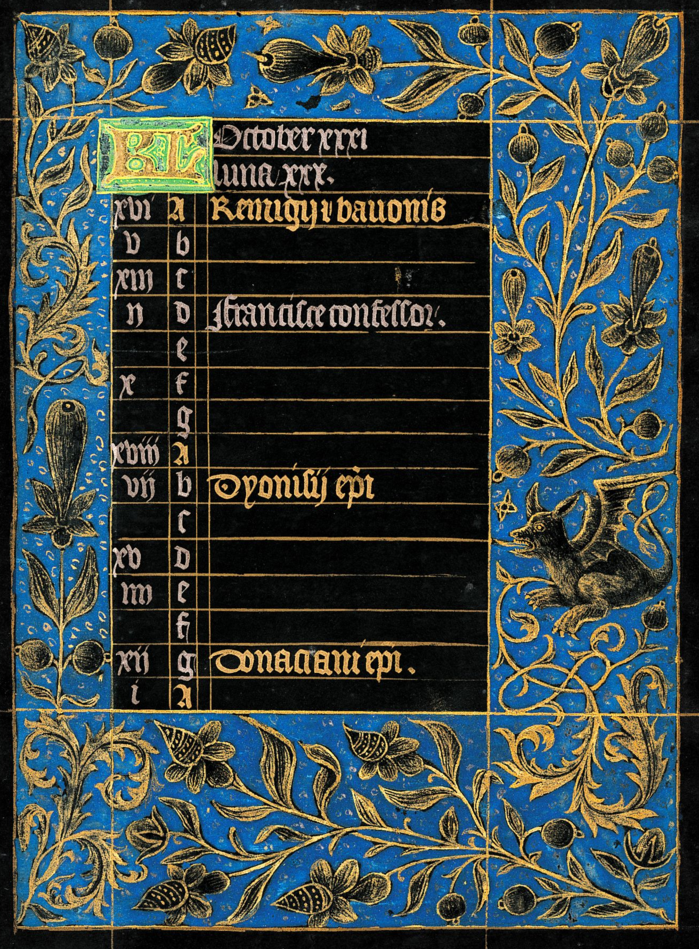
With Walters Art Museum W.186 we are back to manuscripts from the circle of Willem Vrelant. This is a lovely book, the multiple illustrations of angelic musicians are rightly famous, with, as is sadly common, a rather undecorated calendar. There’s no illumination on the calendar except the KL at top, even the space for the more decorated ‘A’ in the dominical letters is unfilled. In the dominical letters there’s also a duplicate, the G for July 15 is written at the bottom of f.7r and the top of 7v.
The most interesting bit, however, is the beginning of the month of October(see f.10r below). The usual saint for October 1, Bishop Remigius of Reims, has been pushed to October 2. Listed on October 1, in red, are Sts. Bavo, an unusual but by no means unique saint for that day often seen in Dutch and Flemish manuscripts, and St. Gaidii. The catalogue interprets this as a variant of Aegydius, but the usual day him is September 1, and I’ve found no reference to a variant date of October 1. For now I am leaving this entry untagged, hopefully another example will come along and help clarify things
(DB Id: 209)
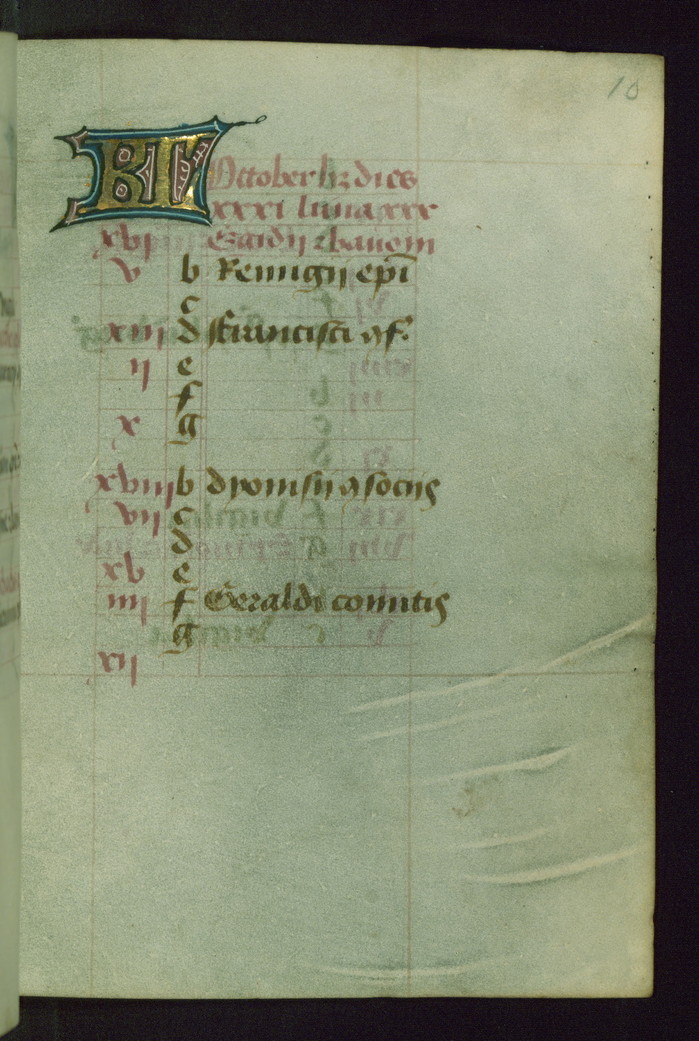
The Walters Art Museum has revamped their website, which makes finding their digitized assets easier. From the new website comes W.90, an early 14th Century Book from the area of St. Omer, France. The most interesting part of the manuscript, for most people, comes after the calendar. There are 7 full-page miniatures, depicting the beginning of Genisis, from Creation through the expulsion, contained within highly-detailed architectural frames.
The calendar itself is not uninteresting, though. It is an early example of a nearly complete calendar, 359 of the entries are populated. There are very few in red, not even all of the Apostles get ranked, and many of the major feasts lack Vigils. Both of these are more obvious at the beginning of the MS, the first vigil is June 23, Vigil for St. John, and there are only 10 red days through the end of May, but a total of 49.
The feasts named are a grab bag, some are common, some are specific to St. Omer (Translation of St. Audomer in June 6, Octave of St. Audomar on Sept 16 and Dedication of the Cathedral of St. Audomer on October 17), and some seem to be scribal errors. In this last category are some unusual errors, Mary of Egypt appears on August 4, where perhaps Mary ad Nives, usually Aug 5, was meant.
(DB Id: 198)
Bibliothèque nationale de France Nouvelle acquisition latine 3093 is one of the multiple fragments of a complex manuscript, which was owned and possibly comissioned by Jean, Duc de Berry (yes, that Duc de Berry). The BnF fragment, called the Très Belles Heures de Notre-Dame, is mostly Book of Hours content, but the manuscript originally contained a Psalter and some of a Missel as well. Even without touching on the complex history of creation and illumination, the calendar is interesting in it's own right. The entries are mostly standard for Paris, though there are a large number of local bishops specified with their See, (see Sts. Savian and Potencian, October 19, on f.Vv below. Their see of Sens is recorded). There are also some of the specifically Parisian royal feasts, including both the Crown of Thorns (Aug. 11) and Relics of St. Chapelle (Sept. 30) and multiple kings and queens.
The coloring seems to have no pattern at all, sadly. There are 4 colors used, red, blue, pink (distinct from the red, perhaps a faded purple) and black, which might be lost gold, and many of the feasts have size indications in the right margin (3 or 9 lessons, or Annuale), but there seems to be no correlation between color and rank. High-rank feasts are often blue, but in November, where the month is mostly full, it seems to be a simple pattern (blue is roughly every 3rd feast), and St. Andrew, an apostle, is pink.
(DB Id: 197)
